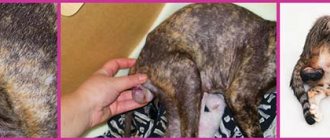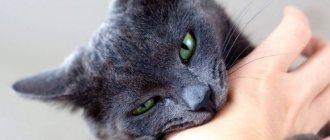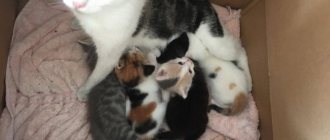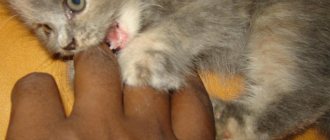How to understand that a cat is giving birth
If there is a pregnant furry beauty in the house, then every owner or breeder looks forward to a joyful and at the same time alarming event - childbirth. As a rule, the time of birth resolution can be calculated with an accuracy of several days, especially if the exact date of fertilization of the animal is known. The duration of pregnancy in a cat is on average 65 - 67 days.
The fact of impending birth is indicated by the so-called precursors - signs indicating the preparation of the cat’s body for labor. They can be observed a couple of days before birth, and sometimes a few hours before the expected event.
| Precursors of childbirth in a cat: |
| 1) The cat seeks privacy, often hiding in closets, dark corners, and boxes. If by this time the owner has prepared a nest for the woman in labor, then she regularly jumps in and out of it, or sits there for a long time. |
| 2) The behavior of the animal changes. The cat may experience anxiety, become aggressive, or, conversely, begin to seek affection and tenderness. Primiparous pets are especially nervous. |
| 3) 1 - 3 days before birth, the mucous plug comes off, and the cat begins to intensively lick the perineal area. |
| 4) When palpating the mammary glands, their enlargement and swelling are noticeable. When you press on the nipple, drops of colostrum appear. |
| 5) Visible swelling of the external genitalia appears, sometimes transparent or pinkish-yellowish discharge is noticeable. |
| 6) 1 - 3 days before birth, body temperature (measured rectally) drops to 37 C. |
| 7) Appetite decreases, thirst or refusal of water may occur. |
It is useful for pet owners to know how long a cat's labor lasts. After all, responsible owners must be present during this process, since the pet may need moral support, and in difficult scenarios, emergency veterinary care. In any case, it is undesirable to leave an animal alone during a difficult and responsible period for it. On average, a normal labor process lasts from several hours to a day. The preparatory phase (described above) is not included in this period. In first-born cats, labor may be delayed for more than a day.
How long it takes a cat to give birth is influenced by many factors and reasons: the health of the pet, the number of previous births, fetal presentation, the hormonal status of the mother, individual characteristics and much more. The owner should understand that childbirth is a physiologically normal, natural process, which should be interfered with only when necessary. Human help is needed if there is a threat to the health of the mother or offspring.
We recommend reading the article on how to deliver a cat. From it you will learn how to prepare for childbirth at home, how to help an animal give birth at different stages of the natural process and avoid complications.
Proper preparation for childbirth
The closer the expected delivery date approaches, the more restless and “cranky” your cat may become. She constantly runs around the house, rushing about, looking everywhere for a place where she can safely give birth. To help your pet, prepare a suitable box or basket in advance . You need to accustom the animal to a new place in advance. If you neglect this simple rule, your cat may well give birth right on your bed.
Some experienced breeders believe that the ideal “container” for the birth of kittens is a small playpen covered with newspapers or paper towels. How can I make sure the box dimensions are correct? It's simple - if the cat can stretch out to its full length in it, then everything is in order - there is enough space for both the mother herself and her entire litter.
The characteristics of the room where you plan to place the birthing basket or box also make a huge difference. If possible, try to choose a quiet and secluded area.
We advise you to avoid even the slightest drafts!!! In small kittens, in the first weeks of their life, the body’s thermoregulation system practically does not function, so babies can freeze to death from the most “innocent” draft.
We also advise you to stock up on towels or clean, dry rags in advance, which will come in handy if you need to dry newborn kittens. In addition, even if you have prepared a basket or box for the birth of kittens, always keep an eye on the cat: these animals are surprisingly principled and independent. If you notice that your pet is constantly sneaking under the bathroom or purposefully climbing into the closet, she almost certainly decided to give birth there. And further. It often happens to inexperienced breeders that by the time the owners notice “oddities” in the behavior of their pet, it turns out that she has already given birth a long time ago. So be careful!
We strongly recommend that you take your cat to the veterinarian within 50-55 days. A specialist will examine the animal and draw conclusions about its health.
In addition, an ultrasound examination is indicated: after it, the owner will know exactly how many kittens should be born. Finally, with the help of ultrasound analysis, the veterinarian can find out in advance about malpresentation and congenital anomalies of the fetuses. This is very important, since with many pathologies of this type, natural and first births are impossible in principle; a caesarean section or even sterilization of the cat is recommended. Finally, you will be prepared for possible problems ahead of time, and therefore will not panic when they arise (probably).
How can you find out exactly when your pet decided to give birth? At home, the simplest and most accurate diagnostic technique is to constantly measure the cat’s body temperature. Approximately one day before the onset of labor, many animals experience a significant decrease in its indicators. Thus, a cat’s normal body temperature ranges from 38.5 to 39.5° Celsius. Immediately before birth (literally a couple of hours before it) it can drop to 37.3° and even lower.
If the time has come, but the process has not started
It often happens that all the expected dates have passed, the animal showed signs of labor, but labor never occurs. In this case, the owner is puzzled by the question of how to induce labor in a cat, and whether this should be done.
Delayed labor severely depletes the animal, causes severe intoxication and can cause stillbirth of fetuses. Therefore, if there is a suspicion of a delay in the labor process, labor stimulation is necessary. The cause of delayed labor may be a large fetus or its incorrect presentation, uterine atony, or a lack of calcium ions.
Only a veterinary specialist can decide on the need to intensify labor after examining the animal. For stimulation, hormonal drugs (oxytocyte, petuitrin) are usually used. Their use is permissible only if the cervix is fully dilated. If the birth canal is not prepared, then the administration of stimulant drugs can lead to injury and even rupture of the cervix, and this is dangerous for the life of the animal.
It is strictly forbidden to independently use folk remedies for inducing labor or hormonal drugs. The use of such substances in a pet that is physiologically unprepared for childbirth can lead to the death of the animal and its offspring. Only a veterinary specialist can decide on the advisability of inducing labor and choosing a hormonal drug.
When you need help during childbirth
In certain situations, cats and kittens clearly need help. The latter will be required under the following circumstances:
- if the cat herself did not free the kitten from the amniotic sac;
- kittens do not come out for a very long time, this especially often happens in the last kitten;
- if the animal has not chewed the umbilical cord;
- part of the kitten has appeared, but the rest of the body does not climb.
In such cases, as a rule, the help of a veterinarian is unnecessary, and an experienced owner can help on his own. But you should call the veterinarian if the following signs occur:
- an unpleasant odor and red discharge came from the vagina;
- pregnancy lasts longer than expected - more than 70 days;
- the temperature rose and a fever began;
- very strong contractions, but kittens are never born.
How does a cat give birth?
The duration of the birth process in cats consists of the preparatory period (phase of the precursors of childbirth), the birth itself and the postpartum (afterbirth) stage. It is useful to know how childbirth occurs in cats and what stage the process is at in order to provide timely assistance if something goes wrong.
Preparation period
The labor process begins with contractions of the uterine muscles (contractions). During this same phase, the cervix begins to dilate. Kittens move through the uterus closer to the birth canal. This process may be accompanied by discharge from the genitals. Contractions become more frequent. They can be felt by placing your palm on the pet’s stomach, and visually in the form of wave-like movements of the abdominal muscles. This phase lasts from 6 to 12 hours. At the same time, the animal breathes heavily, strains, as if going to the toilet, behaves restlessly, constantly licks the genitals, and rakes the bedding with its paws.
How long a cat's contractions last is also influenced by many factors, especially the type of birth the animal has had. In first-time pets, this period can last up to a day. This duration is associated with low hormonal levels and the body’s preparedness for childbirth during the first pregnancy. The duration of the process is very individual. But in any case, you should be patient and not leave your mother alone.
Childbirth itself
At the second stage, contractions become more frequent, the interval between them decreases, and the cervix is fully dilated. During the same period, under the influence of contractions of the uterus, the water sac bursts and the amniotic fluid drains. Under the influence of contractions, the uterus, cervix and vagina form a single birth canal. The animal exhibits attempts—movements of the uterine and abdominal muscles that expel the fetus. As a rule, two attempts are enough to expel the fetus from the female’s genital tract.
Amniotic fluid from the amniotic sac ruptured by contractions promotes the sliding and unhindered movement of the fetus along the birth canal.
Kittens, as a rule, come out into the world in a “diver” position - with their heads and front paws forward. However, breech presentation is also normal. In this case, the baby’s hind legs, tail and pelvis emerge from the birth canal. The expulsion of the fetus from the mother's womb does not occur at once. The baby may appear and disappear from the vagina several times.
Anterior presentation
Posterior presentation
After birth, the cat intensively licks the kitten and frees it from its shell. The cubs are born with an umbilical cord, which the mother grinds with her teeth and then gnaws. Such actions prevent the development of bleeding, as the vessels become twisted and a blood clot quickly forms.
Postpartum period
The third stage of labor is the subsequent stage. During this period, the placenta is expelled from the birth canal if it does not come out with the fetus. Obeying natural instinct, the cat eats the afterbirth. In the wild, this is associated with clearing the birth site from the development of infection and hiding the nest from predators and scavengers. At home, you can allow your pet to eat no more than two afterbirths to avoid indigestion and to replenish energy losses during the process.
Kittens with afterbirth
The owner should also ensure that the number of placenta corresponds to the number of kittens born. Delayed passage can lead to the development of an inflammatory process in the uterus, which is unsafe for the health of the animal.
Features of childbirth in a Scottish cat
Tarts stand out indicatively even in the process of harbingers of childbirth. In contrast to her usual calm behavior, she becomes aggressive and anxious. “Nests” vigorously, looking for a secluded corner for childbirth: digging through rubble of clothes, hiding in drawers, crawling under the sofa. Ideally, the owner should help create a place for the pet to give birth: a spacious box or drawer, covered with sterile diapers and equipped with a bowl of water. On the day of delivery, the cat begins to behave restlessly, chase the owner, and meow helplessly and pitifully.
Recommended reading:
What to feed a pregnant cat: nutritional rules
In about a day, the animal stops eating and drinks only water. If a cat walks around the apartment and meows loudly, most likely she is having contractions and experiencing pain. Dilated pupils and irregular breathing indicate that she is scared. The pet needs to be petted, calmed and returned to its nest. Most likely, repeatedly. A primiparous mother may ignore her kittens at first. This will continue until the production of the necessary hormones increases, she will not touch them. This is not something to be afraid of.
General information about the time of delivery
The interval between the births of kittens is usually 10 - 15 minutes. In rare cases, the time of birth of the next baby is delayed up to 2 - 3 hours. Sometimes labor activity after the birth of three or four kittens is suspended for 12 - 24 hours, and then resumes again. This is quite normal for the cat family.
It is important for the owner of the animal to know how many hours a cat’s labor lasts. This information is necessary in order to have an idea of how much time you will need to devote to your pet. After all, even if the birth takes place without complications, this does not mean that the cat should be alone. An animal may need moral support and the help of a loving owner at any stage of labor.
Childbirth in domestic cats is a very individual process. It is not possible to accurately determine their duration. However, the owner should know that on average labor lasts from several hours to a day. The average cat gives birth to kittens in 4 to 8 hours. Therefore, if labor lasts more than a day, you should consult a veterinarian.
Why a cat may not give birth to all kittens at once
At what age can a cat become pregnant for the first time?
Can a cat still have a kitten in her stomach after giving birth? This situation is quite possible due to the following reasons:
- young or too old age of mother;
- poor health or serious illness in your pet;
- hormonal state of the body;
- insufficient care during pregnancy and childbirth;
- diet.
Other reasons are also possible. The condition of the animal in the last week is especially important. Stress and fear are undesirable and pose a danger to both the cat and her babies.
Before giving birth, the cat must be protected from stress, otherwise it may not give birth.
The main signs of the end of labor
When a cat gives birth, it is important to make sure everything is successful in the end. This can be judged by the presence of the following signs:
- As soon as the mother realizes that all the kittens are out, she begins to actively care for the offspring, feeding them milk. At the same time, the cat intensively licks the babies, feeds them, purrs;
- If you listen to your breathing, you will find that it is even. Heart beats and pulse are rhythmic and follow at a normal speed;
- Mom eats and drinks with pleasure;
- the pet is able to get up and walk at least a little;
- when labor ends, if palpation is done no earlier than 40 minutes later, the abdomen will feel soft and relaxed to the touch. When palpating, you cannot feel the presence of seals. The muscles may be tense for a short period of time, but this quickly passes.
An indirect sign of a favorable end of labor may be the natural and calm behavior of the pet. However, it is normal for some cats to remain calm even when giving birth.











